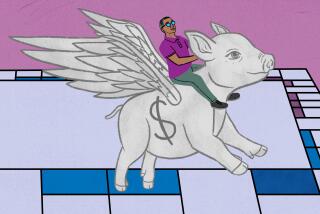Book review: “Houseonomics: Why Owning a Home Is Still a Great Investment,” by Gary N. Smith and Margaret H. Smith
- Share via
With home prices continuing to fall -- and expected by many experts to decline further before finding a bottom -- it’s very easy to play that “woulda, shoulda, coulda” game and envision how life might have been different had you sold that home back in 2005 and run off with the profit to Tahiti.
But in their new book “Houseonomics: Why Owning a Home Is Still a Great Investment,” authors Gary N. Smith and Margaret H. Smith would argue against that type of thinking entirely, because it ignores what they call the “home dividend.”
In fact, they contend that for most people in most places, now is a good time to own a home. In some areas of the country -- such as Indianapolis, Atlanta and New Orleans -- homes can even provide double-digit after-tax returns.
How can this be? Gary Smith and Margaret Smith, who hold doctorate degrees in economics from Yale and business economics from Harvard, respectively, said the home dividend was the amount homeowners saved by investing in their own homes instead of renting. This dividend is calculated by determining the market rent for the same type of home, subtracting costs for mortgage payments, property taxes, insurance and maintenance or homeowners association fees, and then adding in any tax savings.
If saved and invested like income from a stock portfolio, any positive balance could then fund future expenses for vacations, college tuition or even a more comfortable retirement. Even better, the unique tax advantages provided by the government for homeownership -- including mortgage interest deductions and generous tax exemptions on profits for most owner-occupied home sales -- have, according to the book, helped homeowners amass an average net worth of nearly $200,000 versus less than $5,000 for renters. Since homeowners have just twice the annual income of renters, the authors conclude that most of that additional net worth is due to homeownership.
Although it might seem odd timing to release such a book during the current phase of this housing cycle, the Smiths assert that many financial experts and housing doomsayers overlook housing’s current investment benefits by focusing too much on short- and medium-term swings in prices. They strongly advise against flipping homes as speculators, using home equity for purchases that don’t improve a dwelling or even buying income property unless the resulting home dividend is comparable to other non-housing investments -- much like a stock.
Gary Smith, who teaches economics at Pomona College in Claremont, argues that most comparisons of home prices to incomes generally ignore the effect of interest rates and potential cash flow. “Everyone’s got to live somewhere, so do you want to pay by renting or buying?” he asks. “That’s the crucial question.”
Fortunately, the book not only provides the basic steps to calculate home dividends for owner-occupied and investment properties but also provides comprehensive advice with chapters covering when to buy, finding the right home, taking on appropriate levels of debt, selecting the right mortgage, when to refinance or tap a home-equity line, remodeling, the pros and cons of owning investment and vacation homes, viewing a home as an important part of a retirement portfolio and the steps to take when eventually selling.
Appendixes provide examples on how to calculate home dividends for real-world examples of owner- and renter-occupied houses cited earlier in the book, so readers can plug in their own figures matched to their individual circumstances. For example, although buying a rental home in Indianapolis might seem like a great idea to Southern Californians because of the relatively low sale prices and decent rents, the potential home dividend is gradually eroded when factoring in the costs of traveling to and managing an out-of-state property. The Houseonomics website, at www.houseonomics.com, provides online calculators.
Of course, there is another crucial step to creating long-term wealth, since a small negative dividend in the first few years will slowly rise as rents increase with inflation and the savings from not renting grow over time. That step is called patience.
More to Read
Sign up for The Wild
We’ll help you find the best places to hike, bike and run, as well as the perfect silent spots for meditation and yoga.
You may occasionally receive promotional content from the Los Angeles Times.










